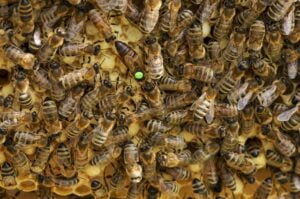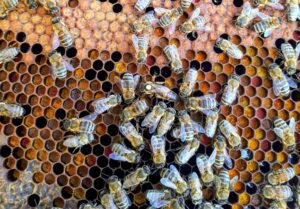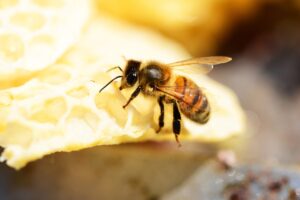Honey bee drones, essential male bees within a colony, play a pivotal role in the reproductive success and genetic diversity of honey bee populations. Unlike their female counterparts, drone bees do not engage in hive tasks like foraging or nursing brood. Instead, their primary function revolves around honey bee mating with virgin queens from other colonies during mid-air flights. This process, crucial for genetic exchange and colony resilience, ensures the propagation of diverse genetic traits vital for adapting to environmental changes and combating diseases. Understanding the anatomy, life cycle, and behavioral traits of honey bee drones sheds light on their significance in maintaining colony dynamics and sustaining honey bee populations worldwide.

Table of Contents
Understanding Honey Bee Drones
Anatomy and Characteristics
Honey bee drones are larger than worker bees, with stout bodies and large eyes that help them navigate during honey bee mating flights. They do not possess stingers, and their primary function revolves around reproduction. Drone bees are physiologically adapted for mid-air mating with queen bees.
Life Cycle and Development
Drones develop from unfertilized eggs laid by the queen bee. Their development takes 24 days from egg to emergence as adults. Drones play a critical role during the mating season, contributing to genetic diversity in honey bees. They are typically expelled from the hive during times of resource scarcity.
Behavioral Traits of Drone Bees
Drones are known for congregating in drone congregation areas (DCAs) during the mating season, where they wait for queens to arrive for mating flights. This behavior ensures the propagation of honey bee genetics across different colonies. Drones are less involved in hive maintenance and foraging activities compared to worker bees.
1. Mating with Queens
Mid-Air Honey Bee Mating Process
Honey bee drones are essential for the colony’s reproductive success, primarily through their role in mating with virgin queens. Drones reach sexual maturity around 12 days after emerging from their cells. During the mating season, which typically occurs in spring and early summer, drones leave their hive and gather in specific areas known as drone congregation areas (DCAs).
These DCAs are typically located in open areas, often several meters above the ground, where drones from multiple colonies congregate. Interestingly, these locations often remain consistent from year to year, suggesting a form of traditional knowledge or genetic predisposition guiding their selection.
When a virgin queen leaves her colony for her mating flight, she navigates towards a DCA, guided by environmental cues and pheromones released by drones. Once she arrives, multiple drones compete for the opportunity to mate with her. Mating occurs mid-air, and the process is rapid but crucial for the colony’s genetic diversity.
During mating, a drone grasps the queen with his genitalia, called an endophallus, and inseminates her with sperm stored in his seminal vesicles. This mating process is fatal for the drone, as his endophallus is torn from his body upon ejaculation. After mating with several drones during her nuptial flights, the queen stores the sperm in her spermatheca, where it can fertilize eggs throughout her lifetime.
The mating behavior of honey bee drones is essential for genetic diversity within colonies. By mating with queens from other colonies, drones introduce genetic variation that enhances colony resilience and adaptation to environmental changes. This genetic diversity also plays a crucial role in disease resistance, as it reduces the risks associated with genetic homogeneity.
In summary, honey bee drones’ mating behavior involves a fascinating interplay of instinct, environmental cues, and reproductive biology. Their role in the colony dynamics extend beyond reproduction, influencing the genetic makeup and resilience of honey bee populations worldwide.
Genetic Diversity in Honey Bees
By mating with queens from different colonies, drone bees introduce genetic variation crucial for the colony’s adaptation to environmental changes and disease resistance. This diversity enhances the overall health and vigor of honey bee populations.
2. Maintaining Colony Dynamics
Social Interaction Impact
Drones contribute to the overall balance within the colony through their interactions with worker bees and the queen. Their presence influences the behavior and productivity of worker bees, albeit indirectly, by maintaining social cohesion and optimizing hive dynamics. This interaction ensures that tasks such as foraging, brood care, and hive maintenance are carried out efficiently, contributing to the overall health and productivity of the colony.
Behavioral Influence
Although drones do not engage in typical hive tasks like foraging or nursing brood, their presence affects the social dynamics and efficiency of the colony. They play a role in hive temperature regulation and resource allocation by their clustering behavior and interactions with worker bees. This cooperative effort helps maintain optimal conditions within the hive, ensuring that the colony functions smoothly and efficiently.
3. Ensuring Genetic Diversity
Cross-Colony Genetic Exchange
By mating with queens from other colonies, drones facilitate the exchange of genetic material between colonies. This genetic diversity is crucial for the colony’s ability to adapt to changing environmental conditions and resist diseases, as it introduces new variations that enhance the colony’s resilience and ability to thrive in diverse ecological settings. This genetic exchange also plays a significant role in maintaining the long-term health and sustainability of honey bee populations worldwide.
Adaptability and Resilience
Genetic diversity reduces the risks associated with inbreeding and enhances the colony’s ability to thrive in diverse ecological environments. Drones’ role in genetic diversity contributes to long-term colony health and sustainability.
4. Social Impact on Hive Efficiency
Resource Allocation Influence
Drones’ presence within the hive exerts a subtle yet significant influence on hive dynamics, primarily through their interactions with worker bees. While drones do not participate directly in tasks like foraging or brood care, their presence affects the social dynamics and resource allocation within the colony. Drones often congregate in specific areas of the hive, which can influence how worker bees move and distribute resources such as pollen and nectar. This interaction indirectly impacts colony productivity by influencing the efficiency with which worker bees perform their tasks.
Temperature Regulation
Moreover, drones play a role in maintaining hive temperature and humidity levels. Their clustering behavior during colder periods helps regulate hive temperature, contributing to overall colony thermoregulation. This cooperative effort among drones and worker bees ensures that the colony remains within the optimal temperature range for brood development and hive function. Thus, while drones’ direct contributions to hive management are limited, their presence and behavioral patterns play a crucial role in maintaining the balance and efficiency of the hive ecosystem.
5. Evolutionary Significance
Species Survival Strategy
Drones’ primary evolutionary role lies in their contribution to the survival and adaptation of honey bee species. Their ability to mate with queens from different colonies ensures genetic diversity, which is essential for species resilience.
Long-term Population Health
Over millions of years, the role of drones in mating behavior and genetic diversity has contributed to the evolutionary success of honey bee populations worldwide. Their unique reproductive role enhances colony dynamics, survival and adaptability.
Additional Resources
6 Ways Queen Bees Influence Hive Behavior and Productivity
Understanding the 4 Life Stages of a Honey Bee Worker: Insights for Beekeepers
The Invisible Work of Honeybee Drones
Conclusion
Honey bee drones play a pivotal role in the reproductive success and genetic diversity of honey bee colonies. Their specialized anatomy and behavior, including their unique mating process in drone congregation areas (DCAs), ensure the propagation of diverse genetic traits crucial for colony resilience and adaptation. By mating with virgin queens from other colonies, drones facilitate genetic exchange that enhances the overall health and vigor of honey bee populations.
Understanding the intricate dynamics of honey bee drones provides insights into their evolutionary significance and ecological impact. As key contributors to colony dynamics and genetic diversity in honey bees, drones contribute to the long-term sustainability of populations worldwide. By preserving their habitats and ensuring optimal conditions for mating, we can support the essential role of honey bee drones in maintaining healthy ecosystems and agricultural productivity.
Explore more about honey bee drones and their crucial contributions to colony resilience, genetic diversity, and ecosystem health to appreciate their significance in the broader context of beekeeping and environmental conservation.



